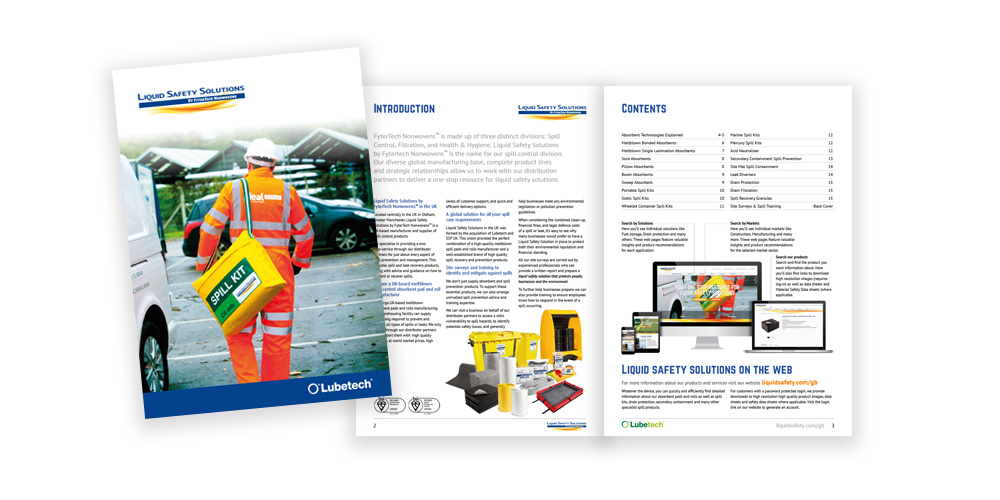Oil & Gas
Spill Control Solutions for Oil and Gas
Spill solutions for oil and gas applications cover a wide range of absorbents and spill management equipment.
What type of absorbent is best suited for Oil and Gas?
More often than not absorbents designed just to recover oil-based fluids will be more suitable and practicable to the oil and gas industries. For more general maintenance and servicing purposes absorbents that recover both oil-and water-based fluids at the same time will be better suited.

White coloured Oil Only absorbents are hydrophobic. They absorb just oil-based fluids but repel water-based fluids. For locations outside, in or on large bodies of fresh or saltwater subjected to weather exposure, Oil only absorbents are particularly suited, as they will only recover oil-based fluids without soaking up any water.

Grey/black Maintenance absorbents are hydrophilic and take up both water-based fluids along with oil-based fluids at the same time. These are the best all-round option for recovering spills of any type.
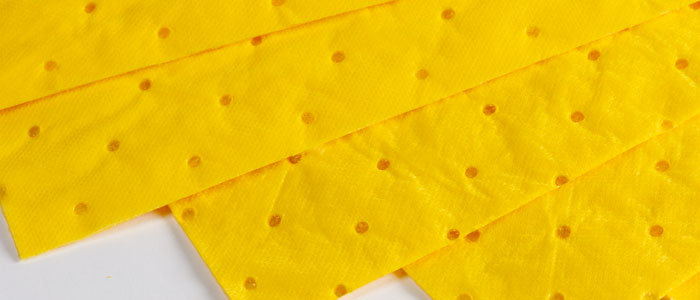
Yellow Chemical absorbents are also hydrophilic and will absorb both oil- and water-based fluids at the same time. The yellow colour of these absorbents indicates that they should be used for recovering aggressive fluids such as acids and alkalis and once used should be treated and disposed of with extreme caution.
In most instances white Oil only absorbents will be best suited to the vast majority of tasks involved in oil and gas refining, transportation and distribution. For vehicle fleet management, fuelling and servicing, Oil Only absorbents will provide the better option here too. For more generic building maintenance and cleaning grey Maintenance absorbents will cover the tasks at hand. For any aggressive spills like acids or alkalis yellow Chemical absorbents should be the default choice.
Environmentally friendly options
As a limited alternative to the above we offer a range of environmentally friendlier absorbents. These are either made from recycled meltblown polypropylene or are made from cellulose natural fibres. These environmentally friendly absorbents can be included towards achieving an ISO 14001 Environmental Management Standard.
Natural fibre absorbents are in some cases more absorbent. However, choosing an environmentally friendly absorbent needs to be considered carefully as a used or contaminated absorbent will need to be disposed of exactly the same way as a meltblown polypropylene absorbent.
What absorbent formats are best suited to Local Oil and Gas?
Pads are available in different weights (light- through to -heavy weights) and also in un-bonded, bonded and laminated constructions. As a guide, the heavier the weight, the more fluid it will absorb. With regards to the construction, laminated pads are stronger and feature less linting (stray fibres becoming detached), bonded pads are slightly more absorbent, and un-bonded pads the most absorbent but not as strong. For wiping, rubbing and general cleaning we generally recommend a medium weight single laminate Maintenance pad. For oil-based spill recovery on bodies of water we recommend an un-bonded Oil only pad.
Rolls are exactly the same as pads but instead are formed of longer lengths of absorbent which are rolled up. Rolls of absorbent are ideal for rolling out over larger areas to collect spilled or leaked fluids. We recommend a single laminate absorbent with the meltblown core face down when used next to machinery. This maximises the absorption of fluids whilst reducing the slip risk. For recovering oil-based spills on foreshores un-bonded Oil only absorbent roll is best.
Socks and Pillows are used to collect spills or leaks from around or beneath vehicles, plant or machinery. Socks are used to contain the fluid by providing a barrier whilst also absorbing the liquid. Pillows are for capturing leaks or spills under machinery that are too big for a pad.
Drum Tops sit inside the rim of a standard oil-drum and capture spills involved in transferring fluids.
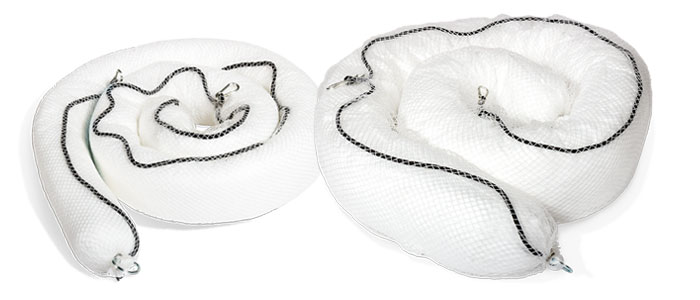
Booms are long flexible tubes of absorbent that can be floated on the water surface to surround and prevent spills or leaks from spreading whilst also absorbing the fluid. These are available in different lengths. Eyes and snap-hooks allow multiple booms to be attached together to form long floating barrages. A 20 cm diameter boom is available for conditions where larger waves are present. A smaller 13cm diameter boom is available for inshore or inland water locations such as rivers, ponds or lakes.
Sweeps are long ‘curtains’ of polypropylene that are designed to be towed behind a boat or secured across a water course to collect the final sheen of oil from the surface of the water.
Spill Depot absorbent dispensers keep the absorbents stored and ready for use on machinery, equipment or fuel storage containers that requires regular liquid spill control. These can be regularly replenished to ensure absorbents are always at hand. Available in a range of sizes and either wall-mounted or free-standing formats ensures there will be a configuration suitable for any business’s requirements.
Safety-first High-Visibility absorbents
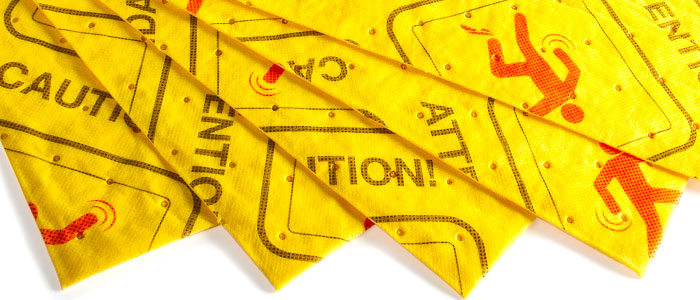
Our Spillfyter high-visibility range of absorbents are an excellent choice for areas of hard floor surfaces that see regular foot fall. These high-visibility absorbents are perfect for drawing attention to and warning of the slip-risk of spilled or leaked fluids whilst also recovering the spill or leaked fluid at the same time. These high visibility absorbents can be used at entrances, in reception areas, communal areas or in areas where staff or the public gather such as meeting rooms and interview rooms.
Bright yellow in colour, these absorbents will recover both oil-based and water-based fluids. They are made from meltblown polypropylene, which ensures they will not react with any chemicals present so are a perfect go-to first choice.
For unplanned liquid spills the high-visibility absorbent with warning text in three languages and graphics warns of the slip risk and recovers the leak or spill at the same time.
This range is available in pads, rolls, and wipes. They also feature a handy range of boxed dispensers and warning stands.
Protecting the workforce
For unexpected spills and leaks it is essential to have the correct liquid safety solutions in place to be able to respond accordingly. In most cases a spill kit or range of strategically located and readily available spill kits will provide all the absorbents and a container needed to recover the spill.

Portable spill kits allow a quantity of absorbents to be taken to the site of a spill or leak quickly. Available in both Oil-only and Maintenance types and a range of sizes up to 50ltrs.
Static spill kits are best located where there is a chance of a spill occurring and providing mitigation against the risk. Available in an 80ltr size in either Oil-only or Maintenance types.
Wheeled spill kits range from 120ltr up to 1,000ltr and in both Oil-only and Maintenance types. These highly manoeuvrable spill kits are an essential choice for dealing with unplanned spill types. With a ‘polluter pays’ policy it is easy to see how these spill kits can pay for themselves. To protect the initial investment, we provide spill kit refills to ensure the spill kits are always ready and on stand-by.
Bio-hazard Spill Kits offer neater and compact spill kits that are portable or easy to store ready for use when needed. They provide everything required to contain, recover and dispose of bodily fluids whilst protecting from the risks associated with contamination or infection.
Secondary Containment for storing and supplying oil and fuels
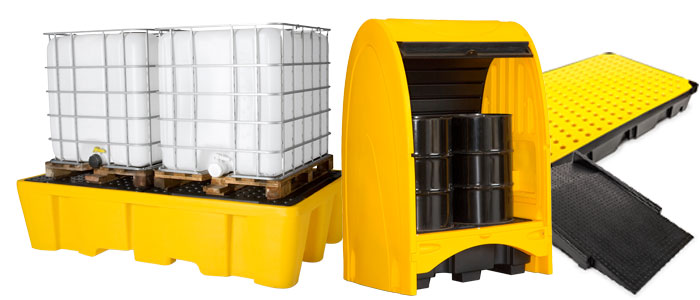
These hard plastic (usually polypropylene) containers take the form of spill pallets, work floors and mobile transport devices. Each features a regulation compliant sump capacity to hold a percentage of the stored container’s capacity.
Workfloors are modular decks that can be attached together to form larger working surfaces. Each workfloor has a grated surface suspended above a sump which allows any spilled fluids to drain through and remain in the sump. The spilled fluid can be drained off and stored safely. Ramps and other accessories allow access with wheeled trollies.
Spill Pallets are modular units that allow storage of standard unit containers that can range from smaller plastic bottles to larger metal drums and caged IBC containers. Weather protection editions prevent the sump being contaminated with water or filling with rainwater and reducing the sump capacity for additional spilled fuel.
Spill or Drip Trays are smaller free-standing units that can accommodate containers of fuels or solvents and protect them from reaching the environment.
Site Mat is a two-part unit which is placed under plant or equipment when being refuelled or serviced. An inner polypropylene liner filters and traps the oil-based spilled liquid or leaked fuel, while the porous side walls allow rainwater to simply run off.
Storage
We have a wide range of storage cupboards in metal and plastic. Available in different sizes and shapes, ask us for more details to suit specific requirements.
The cost of slips and trips
31% of workplace accidents involve slips, trips or falls. This comes at a cost of around £512m a year to UK industry and businesses. These devastating costs to both individuals and to businesses is the reason why having a liquid safety solution is so important. Contact us today for more information.
The law from the HSE
The Health and Safety at Work etc Act 1974 (HSWA)
The Health and Safety at Work Act 1974 requires employers to ensure the health and safety of all employees and anyone affected by their work, so far as is reasonably practicable, which means balancing the level of risk against the measures needed to control the risk in terms of money, time or trouble. This includes taking steps to control slip and trip risks.
Employees have a duty to take care of their own health and safety and that of others and must use any safety equipment provided.
Health and Safety at Work etc Act 1974
The Management of Health and Safety at Work Regulations 1999 (Regulation 3)
Build on the HSWA and include duties on employers to assess risks (including slip and trip risks) and take action where necessary.
Management of health and safety at work
The Workplace (Health, Safety and Welfare) Regulations 1992 (Regulation 12)
Require floors to be suitable, in good condition and free from obstructions. People should be able to move around safely.
The Workplace (Health, Safety and Welfare) Regulations 1992
Site Surveys and Spill Recovery training
To help you identify spill and leak risks we can provide a site survey. An experienced and highly knowledgeable member of our team can attend a site to assess and provide a written report identifying the risks. Along with the risk identification, a suggestions of liquid safety solutions will be made available.
To allow a business’s employees to better respond to a spill we can provide spill training to ensure that in the event of a spill everybody knows how to safely respond and follow a set procedure.


